茶余饭后-cython逆向-语言特性分析
推荐 原创【茶余饭后-cython逆向-语言特性分析】此文章归类为:茶余饭后。
Cython学习
1.概述
1.简述
之前遇到的很多python题目逆向都是pyc的逆向比较简单,最近遇到了很多cython的题目,但是不太清楚原理做的就很难受,这里就想梳理一下cython的原理
2.Cython的概述
这里引自官方文档:
Cython - an overview — Cython 3.1.0a0 documentation
Cython是一种编程语言,可以编写 C 扩展 对于 Python 语言来说,就像 Python 本身一样简单 它旨在成为 语言的超集,赋予它高级, 面向对象、函数式和动态编程。
主要的 Python 执行环境通常称为 CPython用 C 语言编写的。 其他主要实现使用 Java 和 Python 本身 。
它的主要特点 :
- 支持可选的静态类型声明,如 语言的一部分。
- 源代码被翻译成优化的 C/C++ 代码并编译为 Python 扩展模块
- 允许程序执行速度非常快,并且与外部 C 紧密集成 库,同时保持高生产力
3.Cython的起源
Cython 项目最初基于著名的 [Pyrex Pyrex] 已经通过源代码编译器解决了这个问题 将 Python 代码转换为等效的 C 代码
特性:
- 保留了 Python 的原始界面源代码
- 可以直接从 Python 代码中使用
- 使用快速二进制模块扩展 CPython 解释器
- 将Python 代码与外部C库连接
2.Cython环境配置
与大多数 Python 软件不同,Cython 需要在系统上存在 C 编译器
1.不同系统的配置
1.Linux
GNU C 编译器(gcc)通常存在,或通过包系统轻松获得
在 Ubuntu 或 Debian 命令:
1 | sudo apt-get install build-essential |
2.Mac OS X
木有apple,所以自己官网看
https://developer.apple .com /
3.Windows
使用开源 MinGW(Windows 的 gcc 分发版)
2.安装操作
1.直接包安装
1 | pip install Cython |
2.官网下载安装最新版本
解压缩 tarball 或 zip 文件,输入目录
再运行
1 | python setup.py install |
1 | pip install cython setuptools |
3.语言特性分析
前言
1.学习
跟着无名侠仙贝学习Cython Reverse - Pandaos's blog (panda0s.top)
2.编译
1.原理
Cython 有一个个功能可以将 Python 编译成 C语言实现,再由 GCC/Clang 将 C 编译成动态库
2.build(便于对应分析)
build的源码:
1 2 3 4 5 6 | from setuptools import setupfrom Cython.Build import cythonizesetup( ext_modules = cythonize("hello.pyx", annotate=True)) |
annotate=True 选项可以生成一个 html 页面
==显示 Py源码与生成的C代码的对应关系==
build命令:
1 | python setup.py build_ext --inplace |
成功后在当前目录下找到对应的动态库与对应的 xxx.c 源文件
==直接用 python import 导入==
3.基于Hello.py 编译成的动态库分析
版本: Python 3.7.6,Cython 0.29.21
1.将这个文件改为pyx后缀

2.运行前面的build命令
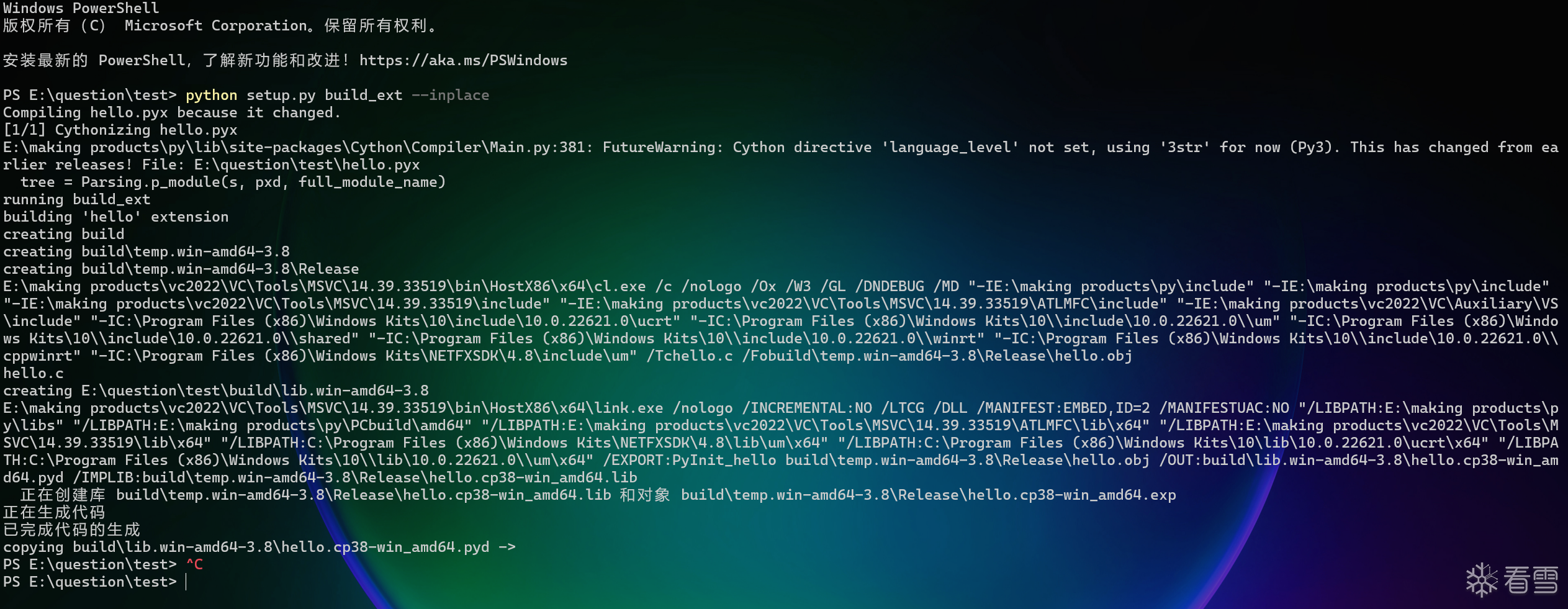
3.进入文件夹中查看便于分析的html文件
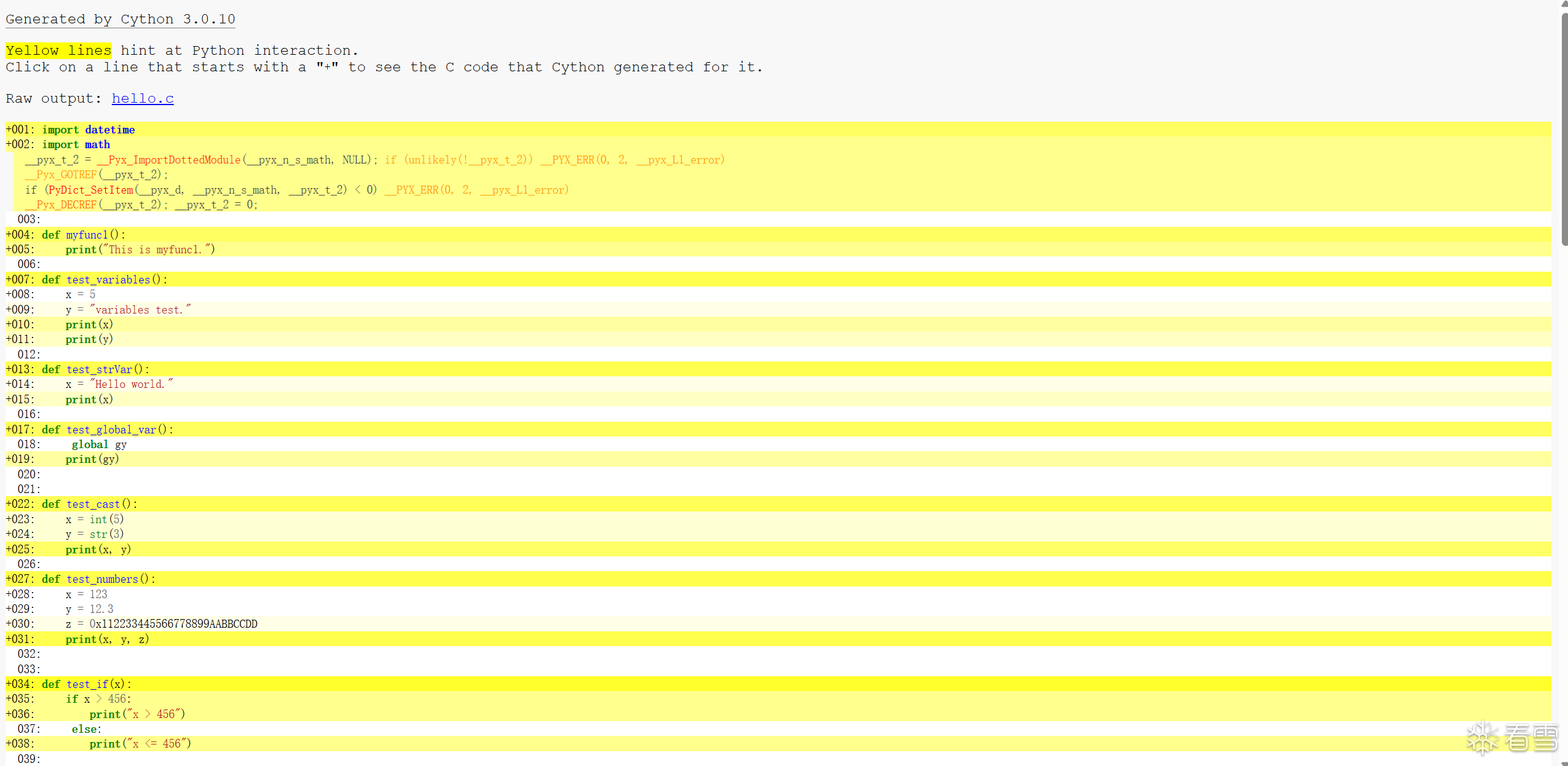
4.源码
1 2 3 4 5 6 7 8 9 10 11 12 13 14 15 16 17 18 19 20 21 22 23 24 25 26 27 28 29 30 31 32 33 34 35 36 37 38 39 40 41 42 43 44 45 46 47 48 49 50 51 52 53 54 55 56 57 58 59 60 61 62 63 64 65 66 67 68 69 70 71 72 73 74 75 76 77 78 79 80 81 82 83 84 85 86 87 88 89 90 91 92 93 94 95 96 97 98 99 100 101 102 103 104 105 106 107 108 109 110 111 112 113 114 115 116 117 118 119 120 121 122 123 124 125 126 127 128 129 130 131 132 133 134 135 136 137 138 139 140 141 142 143 144 145 146 147 148 149 150 151 152 153 154 155 156 157 158 159 160 161 162 163 164 | import datetimeimport mathdef myfunc1(): print("This is myfunc1.")def test_variables(): # 定义局部变量并打印 x = 5 y = "variables test." print(x) print(y)def test_strVar(): # 定义字符串变量并打印 x = "Hello world." print(x)def test_global_var(): # 使用全局变量 gy 并打印 global gy print(gy)def test_cast(): # 类型转换:将整数和字符串进行类型转换并打印 x = int(5) y = str(3) print(x, y)def test_numbers(): # 打印整数、浮点数和大整数(十六进制) x = 123 y = 12.3 z = 0x112233445566778899AABBCCDD print(x, y, z)def test_if(x): # 条件语句:判断 x 是否大于 456 if x > 456: print("x > 456") else: print("x <= 456")def test_string(): # 字符串操作:获取长度、索引、切片,并检查子字符串 x = "I am str." y = len(x) z = x[1] w = x[2:] print(x, y, z, w) if "am" in x: print("yes") else: print("wrong")def test_list(): # 列表操作:添加元素、遍历、切片和替换部分元素 x = list() x.append(1) x.append(2) x.append(3) x.append(4) x.append("five") print(x) print(len(x)) for i in x: print(i) x = x[1:] x[2:4] = [22, 33]def test_dict(): # 字典操作:添加键值对、访问值、检查键和遍历字典 x = {} x["one"] = 1 x["two"] = 2 x["three"] = 3 y = x["one"] z = x["two"] if "one" in x: print(y) for k in x: print(k, x[k])def test_for(): # for 循环:计算 0 到 100 的和 s = 0 for i in range(101): s = s + i print(s)def test_while(): # while 循环:计算 1 到 100 的和 s = 0 i = 1 while i <= 100: s = s + i i += 1 print(s)def test_exception(): # 异常处理:尝试执行错误操作并捕获异常 x = 1 try: x = x + "1" print(x) except NameError: print("Variable x is not defined") except: print("Something else went wrong")def test_datetime(): # 获取并打印当前日期和时间 x = datetime.datetime.now() print(x)def test_format(): # 字符串格式化:使用 % 操作符进行字符串格式化 x = 1 y = "One" z = "%s is %d" % (y, x) print(z)def test_math(): # 数学函数:使用 ceil 和 floor 函数 x = math.ceil(1.4) y = math.floor(1.4) print(x) # 返回 2 print(y) # 返回 1def test_arg(x, y, z): # 传递参数:修改参数并打印 x = x + 1 y = y + "2" z = z[:] print(x, y, z)class test_class: # 定义一个类及其方法 def __init__(self): self.aa = 1 def test_class_hh(self): print(self.aa)# 定义全局变量并调用所有函数gy = 123myfunc1()test_variables()test_strVar()test_global_var()test_cast()test_numbers()test_string()test_list()test_dict()test_for()test_while()test_exception()test_datetime()test_format()test_math()test_arg(1, "2", [4, 5, 6]) |
1.__pyx_string_tab
1.概述
在pyx文件编译为.c的文件时,__pyx_string_tab是一个包含代码中所有需要使用的字符串(避免重复创建相同的字符串,从而优化字符串的使用和查找)
2.查看源码
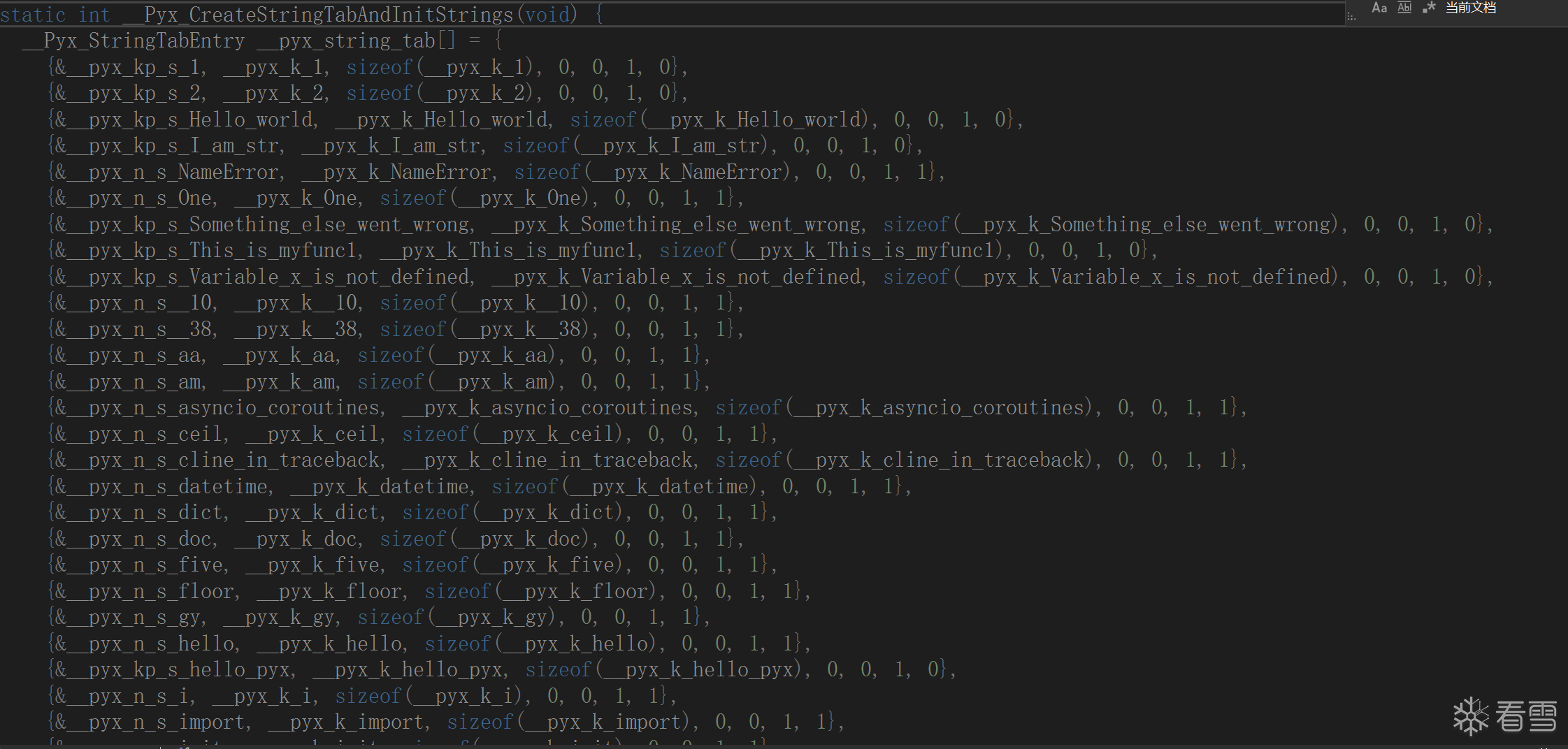
1 2 3 4 5 6 7 8 9 10 11 12 13 14 15 16 17 18 19 20 21 22 23 24 25 26 27 28 29 30 31 32 33 34 35 36 37 38 39 40 41 42 43 44 45 46 47 48 49 50 51 52 53 54 55 56 57 58 59 60 61 62 63 64 65 66 67 68 69 70 71 72 73 74 75 76 77 78 79 80 81 82 83 84 85 86 | static int __Pyx_CreateStringTabAndInitStrings(void) { __Pyx_StringTabEntry __pyx_string_tab[] = { {&__pyx_kp_s_1, __pyx_k_1, sizeof(__pyx_k_1), 0, 0, 1, 0}, {&__pyx_kp_s_2, __pyx_k_2, sizeof(__pyx_k_2), 0, 0, 1, 0}, {&__pyx_kp_s_Hello_world, __pyx_k_Hello_world, sizeof(__pyx_k_Hello_world), 0, 0, 1, 0}, {&__pyx_kp_s_I_am_str, __pyx_k_I_am_str, sizeof(__pyx_k_I_am_str), 0, 0, 1, 0}, {&__pyx_n_s_NameError, __pyx_k_NameError, sizeof(__pyx_k_NameError), 0, 0, 1, 1}, {&__pyx_n_s_One, __pyx_k_One, sizeof(__pyx_k_One), 0, 0, 1, 1}, {&__pyx_kp_s_Something_else_went_wrong, __pyx_k_Something_else_went_wrong, sizeof(__pyx_k_Something_else_went_wrong), 0, 0, 1, 0}, {&__pyx_kp_s_This_is_myfunc1, __pyx_k_This_is_myfunc1, sizeof(__pyx_k_This_is_myfunc1), 0, 0, 1, 0}, {&__pyx_kp_s_Variable_x_is_not_defined, __pyx_k_Variable_x_is_not_defined, sizeof(__pyx_k_Variable_x_is_not_defined), 0, 0, 1, 0}, {&__pyx_n_s__10, __pyx_k__10, sizeof(__pyx_k__10), 0, 0, 1, 1}, {&__pyx_n_s__38, __pyx_k__38, sizeof(__pyx_k__38), 0, 0, 1, 1}, {&__pyx_n_s_aa, __pyx_k_aa, sizeof(__pyx_k_aa), 0, 0, 1, 1}, {&__pyx_n_s_am, __pyx_k_am, sizeof(__pyx_k_am), 0, 0, 1, 1}, {&__pyx_n_s_asyncio_coroutines, __pyx_k_asyncio_coroutines, sizeof(__pyx_k_asyncio_coroutines), 0, 0, 1, 1}, {&__pyx_n_s_ceil, __pyx_k_ceil, sizeof(__pyx_k_ceil), 0, 0, 1, 1}, {&__pyx_n_s_cline_in_traceback, __pyx_k_cline_in_traceback, sizeof(__pyx_k_cline_in_traceback), 0, 0, 1, 1}, {&__pyx_n_s_datetime, __pyx_k_datetime, sizeof(__pyx_k_datetime), 0, 0, 1, 1}, {&__pyx_n_s_dict, __pyx_k_dict, sizeof(__pyx_k_dict), 0, 0, 1, 1}, {&__pyx_n_s_doc, __pyx_k_doc, sizeof(__pyx_k_doc), 0, 0, 1, 1}, {&__pyx_n_s_five, __pyx_k_five, sizeof(__pyx_k_five), 0, 0, 1, 1}, {&__pyx_n_s_floor, __pyx_k_floor, sizeof(__pyx_k_floor), 0, 0, 1, 1}, {&__pyx_n_s_gy, __pyx_k_gy, sizeof(__pyx_k_gy), 0, 0, 1, 1}, {&__pyx_n_s_hello, __pyx_k_hello, sizeof(__pyx_k_hello), 0, 0, 1, 1}, {&__pyx_kp_s_hello_pyx, __pyx_k_hello_pyx, sizeof(__pyx_k_hello_pyx), 0, 0, 1, 0}, {&__pyx_n_s_i, __pyx_k_i, sizeof(__pyx_k_i), 0, 0, 1, 1}, {&__pyx_n_s_import, __pyx_k_import, sizeof(__pyx_k_import), 0, 0, 1, 1}, {&__pyx_n_s_init, __pyx_k_init, sizeof(__pyx_k_init), 0, 0, 1, 1}, {&__pyx_n_s_init_subclass, __pyx_k_init_subclass, sizeof(__pyx_k_init_subclass), 0, 0, 1, 1}, {&__pyx_n_s_initializing, __pyx_k_initializing, sizeof(__pyx_k_initializing), 0, 0, 1, 1}, {&__pyx_n_s_is_coroutine, __pyx_k_is_coroutine, sizeof(__pyx_k_is_coroutine), 0, 0, 1, 1}, {&__pyx_n_s_k, __pyx_k_k, sizeof(__pyx_k_k), 0, 0, 1, 1}, {&__pyx_n_s_main, __pyx_k_main, sizeof(__pyx_k_main), 0, 0, 1, 1}, {&__pyx_n_s_math, __pyx_k_math, sizeof(__pyx_k_math), 0, 0, 1, 1}, {&__pyx_n_s_metaclass, __pyx_k_metaclass, sizeof(__pyx_k_metaclass), 0, 0, 1, 1}, {&__pyx_n_s_module, __pyx_k_module, sizeof(__pyx_k_module), 0, 0, 1, 1}, {&__pyx_n_s_myfunc1, __pyx_k_myfunc1, sizeof(__pyx_k_myfunc1), 0, 0, 1, 1}, {&__pyx_n_s_name, __pyx_k_name, sizeof(__pyx_k_name), 0, 0, 1, 1}, {&__pyx_n_s_now, __pyx_k_now, sizeof(__pyx_k_now), 0, 0, 1, 1}, {&__pyx_n_s_one, __pyx_k_one, sizeof(__pyx_k_one), 0, 0, 1, 1}, {&__pyx_n_s_prepare, __pyx_k_prepare, sizeof(__pyx_k_prepare), 0, 0, 1, 1}, {&__pyx_n_s_print, __pyx_k_print, sizeof(__pyx_k_print), 0, 0, 1, 1}, {&__pyx_n_s_qualname, __pyx_k_qualname, sizeof(__pyx_k_qualname), 0, 0, 1, 1}, {&__pyx_n_s_range, __pyx_k_range, sizeof(__pyx_k_range), 0, 0, 1, 1}, {&__pyx_n_s_s, __pyx_k_s, sizeof(__pyx_k_s), 0, 0, 1, 1}, {&__pyx_kp_s_s_is_d, __pyx_k_s_is_d, sizeof(__pyx_k_s_is_d), 0, 0, 1, 0}, {&__pyx_n_s_self, __pyx_k_self, sizeof(__pyx_k_self), 0, 0, 1, 1}, {&__pyx_n_s_set_name, __pyx_k_set_name, sizeof(__pyx_k_set_name), 0, 0, 1, 1}, {&__pyx_n_s_spec, __pyx_k_spec, sizeof(__pyx_k_spec), 0, 0, 1, 1}, {&__pyx_n_s_super, __pyx_k_super, sizeof(__pyx_k_super), 0, 0, 1, 1}, {&__pyx_n_s_test, __pyx_k_test, sizeof(__pyx_k_test), 0, 0, 1, 1}, {&__pyx_n_s_test_arg, __pyx_k_test_arg, sizeof(__pyx_k_test_arg), 0, 0, 1, 1}, {&__pyx_n_s_test_cast, __pyx_k_test_cast, sizeof(__pyx_k_test_cast), 0, 0, 1, 1}, {&__pyx_n_s_test_class, __pyx_k_test_class, sizeof(__pyx_k_test_class), 0, 0, 1, 1}, {&__pyx_n_s_test_class___init, __pyx_k_test_class___init, sizeof(__pyx_k_test_class___init), 0, 0, 1, 1}, {&__pyx_n_s_test_class_hh, __pyx_k_test_class_hh, sizeof(__pyx_k_test_class_hh), 0, 0, 1, 1}, {&__pyx_n_s_test_class_test_class_hh, __pyx_k_test_class_test_class_hh, sizeof(__pyx_k_test_class_test_class_hh), 0, 0, 1, 1}, {&__pyx_n_s_test_datetime, __pyx_k_test_datetime, sizeof(__pyx_k_test_datetime), 0, 0, 1, 1}, {&__pyx_n_s_test_dict, __pyx_k_test_dict, sizeof(__pyx_k_test_dict), 0, 0, 1, 1}, {&__pyx_n_s_test_exception, __pyx_k_test_exception, sizeof(__pyx_k_test_exception), 0, 0, 1, 1}, {&__pyx_n_s_test_for, __pyx_k_test_for, sizeof(__pyx_k_test_for), 0, 0, 1, 1}, {&__pyx_n_s_test_format, __pyx_k_test_format, sizeof(__pyx_k_test_format), 0, 0, 1, 1}, {&__pyx_n_s_test_global_var, __pyx_k_test_global_var, sizeof(__pyx_k_test_global_var), 0, 0, 1, 1}, {&__pyx_n_s_test_if, __pyx_k_test_if, sizeof(__pyx_k_test_if), 0, 0, 1, 1}, {&__pyx_n_s_test_list, __pyx_k_test_list, sizeof(__pyx_k_test_list), 0, 0, 1, 1}, {&__pyx_n_s_test_math, __pyx_k_test_math, sizeof(__pyx_k_test_math), 0, 0, 1, 1}, {&__pyx_n_s_test_numbers, __pyx_k_test_numbers, sizeof(__pyx_k_test_numbers), 0, 0, 1, 1}, {&__pyx_n_s_test_strVar, __pyx_k_test_strVar, sizeof(__pyx_k_test_strVar), 0, 0, 1, 1}, {&__pyx_n_s_test_string, __pyx_k_test_string, sizeof(__pyx_k_test_string), 0, 0, 1, 1}, {&__pyx_n_s_test_variables, __pyx_k_test_variables, sizeof(__pyx_k_test_variables), 0, 0, 1, 1}, {&__pyx_n_s_test_while, __pyx_k_test_while, sizeof(__pyx_k_test_while), 0, 0, 1, 1}, {&__pyx_n_s_three, __pyx_k_three, sizeof(__pyx_k_three), 0, 0, 1, 1}, {&__pyx_n_s_two, __pyx_k_two, sizeof(__pyx_k_two), 0, 0, 1, 1}, {&__pyx_kp_s_variables_test, __pyx_k_variables_test, sizeof(__pyx_k_variables_test), 0, 0, 1, 0}, {&__pyx_n_s_w, __pyx_k_w, sizeof(__pyx_k_w), 0, 0, 1, 1}, {&__pyx_n_s_wrong, __pyx_k_wrong, sizeof(__pyx_k_wrong), 0, 0, 1, 1}, {&__pyx_n_s_x, __pyx_k_x, sizeof(__pyx_k_x), 0, 0, 1, 1}, {&__pyx_kp_s_x_456, __pyx_k_x_456, sizeof(__pyx_k_x_456), 0, 0, 1, 0}, {&__pyx_kp_s_x_456_2, __pyx_k_x_456_2, sizeof(__pyx_k_x_456_2), 0, 0, 1, 0}, {&__pyx_n_s_y, __pyx_k_y, sizeof(__pyx_k_y), 0, 0, 1, 1}, {&__pyx_n_s_yes, __pyx_k_yes, sizeof(__pyx_k_yes), 0, 0, 1, 1}, {&__pyx_n_s_z, __pyx_k_z, sizeof(__pyx_k_z), 0, 0, 1, 1}, {0, 0, 0, 0, 0, 0, 0} }; return __Pyx_InitStrings(__pyx_string_tab); |
3.利用
__pyx_string_tab将字符串与PyObject联系,再调用
__Pyx_InitStrings初始化字符串对象(详解__Pyx_InitStrings使用)
C++ __Pyx_InitStrings函数代码示例 - 纯净天空 (vimsky.com)
在逆向时,可以通过这个特性快速找到对应的project
4.辨析一下__Pyx_StringTabEntry和__pyx_string_tab
我在审计的时候发现了__Pyx_StringTabEntry结构体,发现和前面的__pyx_string_tab数组有点关系分析一下
如下:
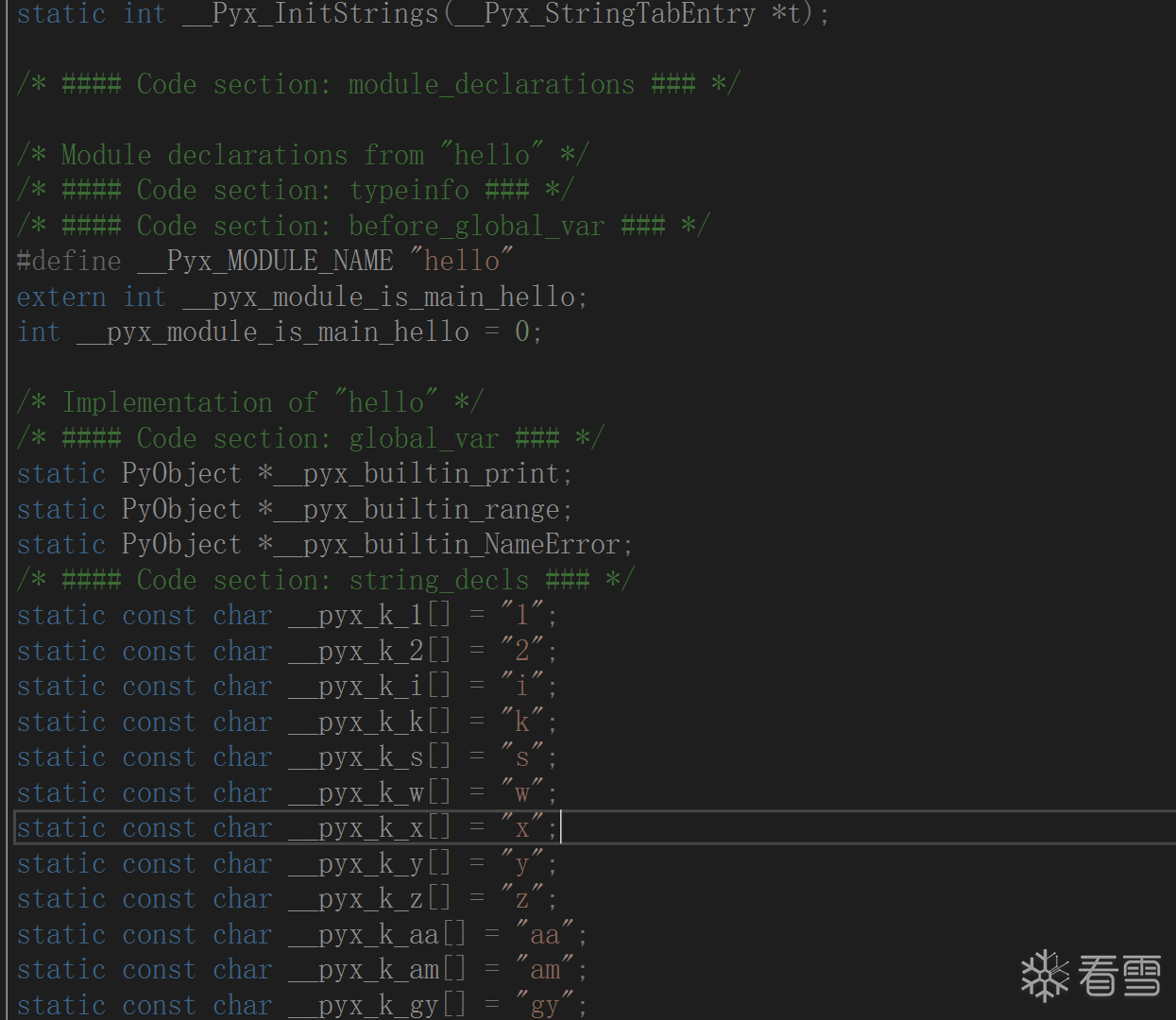
1.Pyx_StringTabEntry结构体的定义
1 2 3 4 5 6 7 | typedef struct { const char *p; /* 存储字符串对象的指针 */ const char *s; /* 字符串的内容*/ Py_ssize_t n; /* 字符串的长度*/ int t; /* 字符串的类型 */ int intern; /* Whether the string is interned or not */} __Pyx_StringTabEntry; |
2.举个例子
1 2 | def greet(): return "Hello, World!" |
cython代码大致结构
1 2 3 4 5 6 | static const char __pyx_k_Hello_World[] = "Hello, World!";static __Pyx_StringTabEntry __pyx_string_tab[] = { {&__pyx_n_s_Hello_World, __pyx_k_Hello_World, sizeof(__pyx_k_Hello_World) - 1, 0, 1}, {0, 0, 0, 0, 0}}; |
完整的实现
在模块初始化过程中,Cython 会调用一个函数(如 __Pyx_InitStrings),使用 __pyx_string_tab 来初始化所有字符串常量,
然后这个函数遍历 __pyx_string_tab,初始化每个字符串条目,并将字符串对象的指针存储在相应的结构体字段中
1 2 3 4 5 6 7 | static int __Pyx_InitStrings(__Pyx_StringTabEntry *t) { while (t->p) { // 初始化字符串对象,并将其指针赋值给 t->p t++; } return 0;} |
2.整数常量的构造
1.概述
整数常量的构造涉及将 Python 代码中的整数常量转换为 C 代码中的相应表示形式。这包括处理各种整数类型(如短整型、整型、长整型和超长整型)以及确保在生成的 C 代码中正确初始化和使用这些常量
2.简要分析
1.整数类型转换
在cython是可以直接引用

1 2 3 4 5 6 7 | def example(): cdef int a = 10 cdef long b = 20 cdef long long c = 30 cdef size_t d = 40 cdef Py_ssize_t e = 50 return a + b + c + d + e |
但是转化为c代码时,类似于(简化版本)
1 2 3 4 5 6 7 8 9 10 11 12 13 14 15 16 17 18 19 20 21 22 | static PyObject *__pyx_pf_7example(void) { int __pyx_v_a; long __pyx_v_b; long long __pyx_v_c; size_t __pyx_v_d; Py_ssize_t __pyx_v_e; PyObject *__pyx_r = NULL; __Pyx_RefNannyDeclarations __Pyx_RefNannySetupContext("example", 0); // 初始化整数常量 __pyx_v_a = 10; __pyx_v_b = 20; __pyx_v_c = 30; __pyx_v_d = 40; __pyx_v_e = 50; // 计算和返回结果 __pyx_r = PyInt_FromLong((__pyx_v_a + __pyx_v_b + __pyx_v_c + __pyx_v_d + __pyx_v_e)); __Pyx_RefNannyFinishContext(); return __pyx_r;} |
2.处理大整数
超出 C 的基本整数类型范围的整数,Cython 使用 Python 的 PyLong 类型来表示
例如:
1 2 3 | def large_int_example(): cdef long long big_int = 12345678901234567890 return big_int |
转换
1 2 3 4 5 6 7 8 9 10 11 12 13 14 | static PyObject *__pyx_pf_14large_int_example(void) { long long __pyx_v_big_int; PyObject *__pyx_r = NULL; __Pyx_RefNannyDeclarations __Pyx_RefNannySetupContext("large_int_example", 0); // 初始化大整数常量 __pyx_v_big_int = 12345678901234567890LL; // 返回结果 __pyx_r = PyLong_FromLongLong(__pyx_v_big_int); __Pyx_RefNannyFinishContext(); return __pyx_r;} |
3.源码分析
整数属于全局变量,在 __Pyx_InitGlobals 中初始化
1 2 3 4 5 6 7 8 9 10 11 12 13 14 15 16 17 18 19 20 | static CYTHON_SMALL_CODE int __Pyx_InitConstants(void) { if (__Pyx_CreateStringTabAndInitStrings() < 0) __PYX_ERR(0, 1, __pyx_L1_error); __pyx_float_1_4 = PyFloat_FromDouble(1.4); if (unlikely(!__pyx_float_1_4)) __PYX_ERR(0, 1, __pyx_L1_error) __pyx_int_0 = PyInt_FromLong(0); if (unlikely(!__pyx_int_0)) __PYX_ERR(0, 1, __pyx_L1_error) __pyx_int_1 = PyInt_FromLong(1); if (unlikely(!__pyx_int_1)) __PYX_ERR(0, 1, __pyx_L1_error) __pyx_int_2 = PyInt_FromLong(2); if (unlikely(!__pyx_int_2)) __PYX_ERR(0, 1, __pyx_L1_error) __pyx_int_3 = PyInt_FromLong(3); if (unlikely(!__pyx_int_3)) __PYX_ERR(0, 1, __pyx_L1_error) __pyx_int_4 = PyInt_FromLong(4); if (unlikely(!__pyx_int_4)) __PYX_ERR(0, 1, __pyx_L1_error) __pyx_int_5 = PyInt_FromLong(5); if (unlikely(!__pyx_int_5)) __PYX_ERR(0, 1, __pyx_L1_error) __pyx_int_6 = PyInt_FromLong(6); if (unlikely(!__pyx_int_6)) __PYX_ERR(0, 1, __pyx_L1_error) __pyx_int_22 = PyInt_FromLong(22); if (unlikely(!__pyx_int_22)) __PYX_ERR(0, 1, __pyx_L1_error) __pyx_int_33 = PyInt_FromLong(33); if (unlikely(!__pyx_int_33)) __PYX_ERR(0, 1, __pyx_L1_error) __pyx_int_100 = PyInt_FromLong(100); if (unlikely(!__pyx_int_100)) __PYX_ERR(0, 1, __pyx_L1_error) __pyx_int_123 = PyInt_FromLong(123); if (unlikely(!__pyx_int_123)) __PYX_ERR(0, 1, __pyx_L1_error) __pyx_int_456 = PyInt_FromLong(456); if (unlikely(!__pyx_int_456)) __PYX_ERR(0, 1, __pyx_L1_error) __pyx_int_0x112233445566778899aabbccdd = PyInt_FromString((char *)"0x112233445566778899aabbccdd", 0, 0); if (unlikely(!__pyx_int_0x112233445566778899aabbccdd)) __PYX_ERR(0, 1, __pyx_L1_error) return 0; __pyx_L1_error:; return -1;} |

3.函数声明
1.概述
2.源码
1 2 3 4 5 6 7 8 9 10 11 12 13 14 15 16 17 18 19 20 21 | static PyObject *__pyx_pf_5hello_myfunc1(CYTHON_UNUSED PyObject *__pyx_self); /* proto */static PyObject *__pyx_pf_5hello_2test_variables(CYTHON_UNUSED PyObject *__pyx_self); /* proto */static PyObject *__pyx_pf_5hello_4test_strVar(CYTHON_UNUSED PyObject *__pyx_self); /* proto */static PyObject *__pyx_pf_5hello_6test_global_var(CYTHON_UNUSED PyObject *__pyx_self); /* proto */static PyObject *__pyx_pf_5hello_8test_cast(CYTHON_UNUSED PyObject *__pyx_self); /* proto */static PyObject *__pyx_pf_5hello_10test_numbers(CYTHON_UNUSED PyObject *__pyx_self); /* proto */static PyObject *__pyx_pf_5hello_12test_if(CYTHON_UNUSED PyObject *__pyx_self, PyObject *__pyx_v_x); /* proto */static PyObject *__pyx_pf_5hello_14test_string(CYTHON_UNUSED PyObject *__pyx_self); /* proto */static PyObject *__pyx_pf_5hello_16test_list(CYTHON_UNUSED PyObject *__pyx_self); /* proto */static PyObject *__pyx_pf_5hello_18test_dict(CYTHON_UNUSED PyObject *__pyx_self); /* proto */static PyObject *__pyx_pf_5hello_20test_for(CYTHON_UNUSED PyObject *__pyx_self); /* proto */static PyObject *__pyx_pf_5hello_22test_while(CYTHON_UNUSED PyObject *__pyx_self); /* proto */static PyObject *__pyx_pf_5hello_24test_exception(CYTHON_UNUSED PyObject *__pyx_self); /* proto */static PyObject *__pyx_pf_5hello_26test_datetime(CYTHON_UNUSED PyObject *__pyx_self); /* proto */static PyObject *__pyx_pf_5hello_28test_format(CYTHON_UNUSED PyObject *__pyx_self); /* proto */static PyObject *__pyx_pf_5hello_30test_math(CYTHON_UNUSED PyObject *__pyx_self); /* proto */static PyObject *__pyx_pf_5hello_32test_arg(CYTHON_UNUSED PyObject *__pyx_self, PyObject *__pyx_v_x, PyObject *__pyx_v_y, PyObject *__pyx_v_z); /* proto */static PyObject *__pyx_pf_5hello_10test_class___init__(CYTHON_UNUSED PyObject *__pyx_self, PyObject *__pyx_v_self); /* proto */static PyObject *__pyx_pf_5hello_10test_class_2test_class_hh(CYTHON_UNUSED PyObject *__pyx_self, PyObject *__pyx_v_self); /* proto *//* #### Code section: late_includes ### *//* #### Code section: module_state ### */ |
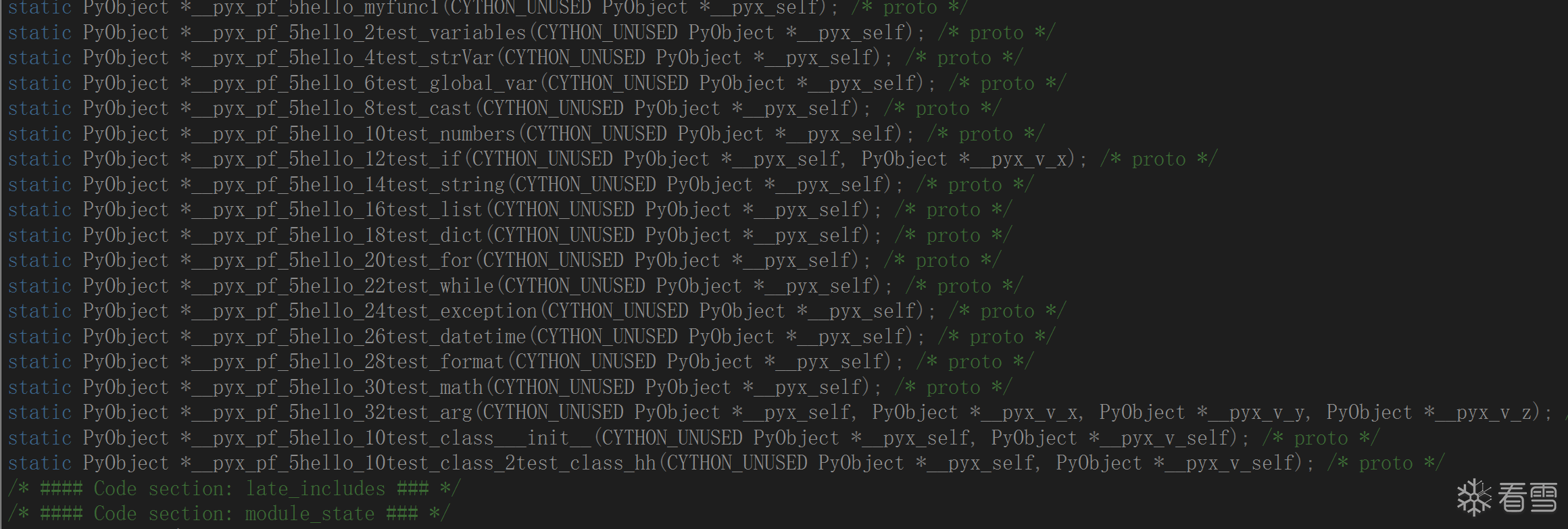
2.详细分析一下__pyx_pf_5hello_32test_arg和 __pyx_pf_5hello_10test_class_2test_class_hh函数
1.__pyx_pf_5hello_32test_arg
这个函数对应于 Python 定义的函数 test_arg(x, y, z),它在 Cython 中被编译成如下形式:
1 2 | def test_arg(x, y, z): # function body |
在 Cython 编译过程中,这个 Python 函数被转换为 C 函数,形式如下:
1 | static PyObject *__pyx_pf_5hello_32test_arg(CYTHON_UNUSED PyObject *__pyx_self, PyObject *__pyx_v_x, PyObject *__pyx_v_y, PyObject *__pyx_v_z); |
1.__pyx_pf_5hello_32test_arg是C 函数的名称
- 前缀 __pyx_pf_是 Cython 生成的函数前缀
- 5hello`表示模块名
- 32test_arg` 表示函数名
2.CYTHON_UNUSED PyObject *__pyx_self 是第一个参数
通常在 Cython 中用作占位符,因为函数没有 self`参数
3.PyObject *__pyx_v_x, PyObject *__pyx_v_y, PyObject *__pyx_v_z 参数
对应于 Python 函数参数 x, y, z`的 C 对象
2.__pyx_pf_5hello_10test_class_2test_class_hh
这个函数对应于一个类方法 test_class.test_class_hh,其 Python 定义如下:
1 2 3 | class test_class: def test_class_hh(self): # method body |
在 Cython 编译过程中,这个类方法被转换为 C 函数,形式如下:
1 | static PyObject *__pyx_pf_5hello_10test_class_2test_class_hh(CYTHON_UNUSED PyObject *__pyx_self, PyObject *__pyx_v_self); |
1.__pyx_pf_5hello_10test_class_2test_class_hh 是 C 函数的名称
- pyx_pf 是 Cython 生成的函数前缀
- 5hello 表示模块名
- 10test_class表示类名
- 2test_class_hh表示方法名
2.CYTHON_UNUSED PyObject *__pyx_self是第一个参数
通常在 Cython 中用作占位符,因为方法没有 self参数
3.PyObject *__pyx_v_self参数
对应于 Python 方法中的 self参数的 C 对象
4.myfunc1() 分析
1.源码
1 2 3 4 5 6 7 8 9 10 11 12 13 14 15 16 17 18 19 20 21 22 23 24 25 26 27 28 29 30 31 32 33 34 35 36 37 38 39 40 41 42 43 44 45 46 47 48 | 04: def myfunc1():/* Python wrapper */static PyObject *__pyx_pw_5hello_1myfunc1(PyObject *__pyx_self, CYTHON_UNUSED PyObject *unused); /*proto*/static PyMethodDef __pyx_mdef_5hello_1myfunc1 = {"myfunc1", (PyCFunction)__pyx_pw_5hello_1myfunc1, METH_NOARGS, 0};static PyObject *__pyx_pw_5hello_1myfunc1(PyObject *__pyx_self, CYTHON_UNUSED PyObject *unused) { CYTHON_UNUSED PyObject *const *__pyx_kwvalues; PyObject *__pyx_r = 0; __Pyx_RefNannyDeclarations __Pyx_RefNannySetupContext("myfunc1 (wrapper)", 0); __pyx_kwvalues = __Pyx_KwValues_VARARGS(__pyx_args, __pyx_nargs); __pyx_r = __pyx_pf_5hello_myfunc1(__pyx_self); /* function exit code */ __Pyx_RefNannyFinishContext(); return __pyx_r;}static PyObject *__pyx_pf_5hello_myfunc1(CYTHON_UNUSED PyObject *__pyx_self) { PyObject *__pyx_r = NULL;/* … */ /* function exit code */ __pyx_r = Py_None; __Pyx_INCREF(Py_None); goto __pyx_L0; __pyx_L1_error:; __Pyx_XDECREF(__pyx_t_1); __Pyx_AddTraceback("hello.myfunc1", __pyx_clineno, __pyx_lineno, __pyx_filename); __pyx_r = NULL; __pyx_L0:; __Pyx_XGIVEREF(__pyx_r); __Pyx_RefNannyFinishContext(); return __pyx_r;}/* … */ __pyx_t_2 = __Pyx_CyFunction_New(&__pyx_mdef_5hello_1myfunc1, 0, __pyx_n_s_myfunc1, NULL, __pyx_n_s_hello, __pyx_d, ((PyObject *)__pyx_codeobj__11)); if (unlikely(!__pyx_t_2)) __PYX_ERR(0, 4, __pyx_L1_error) __Pyx_GOTREF(__pyx_t_2); if (PyDict_SetItem(__pyx_d, __pyx_n_s_myfunc1, __pyx_t_2) < 0) __PYX_ERR(0, 4, __pyx_L1_error) __Pyx_DECREF(__pyx_t_2); __pyx_t_2 = 0;/* … */ __pyx_codeobj__11 = (PyObject*)__Pyx_PyCode_New(0, 0, 0, 0, 0, CO_OPTIMIZED|CO_NEWLOCALS, __pyx_empty_bytes, __pyx_empty_tuple, __pyx_empty_tuple, __pyx_empty_tuple, __pyx_empty_tuple, __pyx_empty_tuple, __pyx_kp_s_hello_pyx, __pyx_n_s_myfunc1, 4, __pyx_empty_bytes); if (unlikely(!__pyx_codeobj__11)) __PYX_ERR(0, 4, __pyx_L1_error)+005: print("This is myfunc1.") __pyx_t_1 = __Pyx_PyObject_Call(__pyx_builtin_print, __pyx_tuple_, NULL); if (unlikely(!__pyx_t_1)) __PYX_ERR(0, 5, __pyx_L1_error) __Pyx_GOTREF(__pyx_t_1); __Pyx_DECREF(__pyx_t_1); __pyx_t_1 = 0;/* … */ __pyx_tuple_ = PyTuple_Pack(1, __pyx_kp_s_This_is_myfunc1); if (unlikely(!__pyx_tuple_)) __PYX_ERR(0, 5, __pyx_L1_error) __Pyx_GOTREF(__pyx_tuple_); __Pyx_GIVEREF(__pyx_tuple_); 006: |
字符串常量
字符串常量 __pyx_kp_s_This_is_myfunc1被初始化为 "This is myfunc1."
创建元组
创建包含该字符串的元组:
1 2 3 4 | __pyx_tuple_ = PyTuple_Pack(1, __pyx_kp_s_This_is_myfunc1);if (unlikely(!__pyx_tuple_)) __PYX_ERR(0, 5, __pyx_L1_error)__Pyx_GOTREF(__pyx_tuple_);__Pyx_GIVEREF(__pyx_tuple_); |
- PyTuple_Pack(1, __pyx_kp_s_This_is_myfunc1):创建一个包含一个元素的元组,该元素是字符串 __pyx_kp_s_This_is_myfunc1
- if (unlikely(!_pyx_tuple)) __PYX_ERR(0, 5, __pyx_L1_error):==检查元组创建是否成功==,如果失败,则跳转到错误处理代码
- __Pyx_GOTREF(_pyx_tuple):==记录元组对象 pyx_tuple 的引用==,防止垃圾回收
- __Pyx_GIVEREF(_pyx_tuple):告诉==垃圾回收器这个对象已经被引用了==
2.分析printf的实现
print("This is myfunc1.")
__pyx_t_1 = __Pyx_PyObject_Call(__pyx_builtin_print, __pyx_tuple_, NULL); if (unlikely(!__pyx_t_1)) __PYX_ERR(0, 5, __pyx_L1_error)
__Pyx_GOTREF(__pyx_t_1);
__Pyx_DECREF(__pyx_t_1); __pyx_t_1 = 0;
/* … */
__pyx_tuple_ = PyTuple_Pack(1, __pyx_kp_s_This_is_myfunc1); if (unlikely(!__pyx_tuple_)) __PYX_ERR(0, 5, __pyx_L1_error)
__Pyx_GOTREF(__pyx_tuple_);
__Pyx_GIVEREF(__pyx_tuple_);
__pyx_t_1 = __Pyx_PyObject_Call(__pyx_builtin_print, _pyx_tuple, NULL); if (unlikely(!__pyx_t_1)) __PYX_ERR(0, 5, __pyx_L1_error) __Pyx_GOTREF(__pyx_t_1); __Pyx_DECREF(__pyx_t_1); __pyx_t_1 = 0;
- __pyx_t_1:存储函数调用的返回值
- __Pyx_PyObject_Call(__pyx_builtin_print, _pyx_tuple, NULL):==调用 print 函数==,参数是 _pyx_tuple(即==包含字符串 "This is myfunc1." 的元组==),没有关键字参数
- ==检查 print 调用是否成功==,如果失败,则跳转到错误处理代码
- __Pyx_GOTREF(__pyx_t_1):==记录 __pyx_t_1 的引用==
- __Pyx_DECREF(__pyx_t_1); __pyx_t_1 = 0:==减少== __pyx_t_1 的引用计数,并将其设置为 0,==防止后续使用无效指针==
3.回收站
前面我们提到了回收站机制,这里详细解释cython中严格处理的回收站的机制
1.基本原理
引用计数:
- 每个对象维护一个引用计数,当有新的引用指向该对象时,引用计数增加;当引用被删除时,引用计数减少
- 当对象的引用计数降为零时,说明没有任何地方引用该对象,可以安全地回收其占用的内存
标记-清除(Mark and Sweep):
- 垃圾回收器定期扫描所有对象,标记可达的(仍在使用的)对象
- 然后清除所有未标记的对象(即不再使用的对象),释放它们占用的内存
2.cython中的调用处理
__Pyx_GOTREF(__pyx_t_1);//增加 __pyx_t_1 的引用计数,表示当前代码块持有这个对象的引用 __Pyx_DECREF(__pyx_t_1); //减少 __pyx_t_1 的引用计数,当引用计数为零时,内存会被回收 __pyx_t_1 = 0;//__pyx_t_1 = 0;:将指针设置为 0,防止悬空指针
3.实现的大致代码框架
# 定义一个 Cython 类 MyClass
cdef class MyClass:
cdef int value # 类的成员变量,类型为 int
# 类的构造函数,用于初始化对象
def __cinit__(self, int value):
self.value = value # 将传入的值赋给成员变量 value
# 类的析构函数,当对象被垃圾回收时调用
def __dealloc__(self):
print("Deallocating MyClass with value:", self.value) # 打印对象被回收时的消息
# 一个方法,用于获取对象的 value 值
def get_value(self):
return self.value
# 创建多个 MyClass 对象的函数
def create_objects(int n):
cdef list objects = [] # 定义一个列表用于存储对象
for i in range(n): # 循环创建 n 个 MyClass 对象
obj = MyClass(i) # 创建一个 MyClass 对象,并传入当前的循环计数 i 作为参数
objects.append(obj) # 将创建的对象添加到列表中
return objects # 返回包含所有创建对象的列表
转换为cython代码
/* Deallocating MyClass with value: ... */
static void __pyx_tp_dealloc_MyClass(PyObject *o) {
MyClass *p = (MyClass *)o;
PyObject_GC_UnTrack(o);
Py_TRASHCAN_SAFE_BEGIN(o)
p->__pyx_vtab = NULL;
__Pyx_call_destructor(p);
PyObject_GC_Del(o);
Py_TRASHCAN_SAFE_END(o)
}
5.test_variables()分析
这里关于def函数的定义比较冗杂,简单看看就行
1.cython生成一个test_variables包装器
static PyObject *__pyx_pw_5hello_3test_variables(PyObject *__pyx_self, CYTHON_UNUSED PyObject *unused); /*proto*/
static PyMethodDef __pyx_mdef_5hello_3test_variables = {"test_variables", (PyCFunction)__pyx_pw_5hello_3test_variables, METH_NOARGS, 0};//定义了一个 PyMethodDef 结构体,将 test_variables 函数绑定到模块 hello 上
2.Python 包装器的实现
static PyObject *__pyx_pw_5hello_3test_variables(PyObject *__pyx_self, CYTHON_UNUSED PyObject *unused) {
CYTHON_UNUSED PyObject *const *__pyx_kwvalues;
PyObject *__pyx_r = 0;
__Pyx_RefNannyDeclarations
__Pyx_RefNannySetupContext("test_variables (wrapper)", 0);
__pyx_kwvalues = __Pyx_KwValues_VARARGS(__pyx_args, __pyx_nargs);
__pyx_r = __pyx_pf_5hello_2test_variables(__pyx_self);//调用实际实现函数_pyx_pf_5hello_2test_variables 并将结果赋给 __pyx_r
/* function exit code */
__Pyx_RefNannyFinishContext();//在函数结束时,完成引用计数管理并返回结果
return __pyx_r;//pyx_r返回值指针,初始为 0
}
- __pyx_pw_5hello_3test_variables是Python 包装器函数,它将调用委托给实际的实现函数 __pyx_pf_5hello_2test_variables
- __Pyx_RefNannySetupContext`和 __Pyx_RefNannyFinishContext用于引用计数管理,帮助避免内存泄漏
- pyx_kwvalues处理可变参数,但这里没有用到,因为函数不接受参数
3.实现函数
static PyObject *__pyx_pf_5hello_2test_variables(CYTHON_UNUSED PyObject *__pyx_self) {//__pyx_pf_5hello_2test_variables 是实际的实现函数
long __pyx_v_x;//__pyx_v_x是局部变量 x,类型为long
PyObject *__pyx_v_y = NULL;//__pyx_v_y是局部变量 y,类型为 PyObject*Python 对象
PyObject *__pyx_r = NULL;
__pyx_v_x = 5;
__pyx_v_y = __Pyx_PyObject_FromString("variables test.");//将y赋值为字符串 "variables test.",并进行错误检查
if (unlikely(!__pyx_v_y)) __PYX_ERR(0, 9, __pyx_L1_error)
__pyx_t_1 = __Pyx_PyInt_From_long(__pyx_v_x); //使用 __Pyx_PyInt_From_long将x转换为 Python 整数对象并打印
if (unlikely(!__pyx_t_1)) __PYX_ERR(0, 10, __pyx_L1_error)
__Pyx_GOTREF(__pyx_t_1);
__pyx_t_2 = PyTuple_New(1);
if (unlikely(!__pyx_t_2)) __PYX_ERR(0, 10, __pyx_L1_error)
__Pyx_GOTREF(__pyx_t_2);
__Pyx_INCREF(__pyx_t_1);
PyTuple_SET_ITEM(__pyx_t_2, 0, __pyx_t_1);
__pyx_t_1 = 0;
__pyx_t_1 = __Pyx_PyObject_Call(__pyx_builtin_print, __pyx_t_2, NULL);
if (unlikely(!__pyx_t_1)) __PYX_ERR(0, 10, __pyx_L1_error)
__Pyx_GOTREF(__pyx_t_1);
__Pyx_DECREF(__pyx_t_2);
__pyx_t_2 = 0;
__Pyx_DECREF(__pyx_t_1);
__pyx_t_1 = 0;
__pyx_t_1 = __Pyx_PyObject_CallOneArg(__pyx_builtin_print, __pyx_v_y);
if (unlikely(!__pyx_t_1)) __PYX_ERR(0, 11, __pyx_L1_error)
__Pyx_GOTREF(__pyx_t_1);
__Pyx_DECREF(__pyx_t_1);
__pyx_t_1 = 0;
__pyx_r = Py_None; //如果没有错误,返回 Py_None (Python 的 None 对象)
__Pyx_INCREF(Py_None);
goto __pyx_L0;
__pyx_L1_error:;//如果有错误,进行错误处理,释放资源并添加回溯信息
__Pyx_XDECREF(__pyx_t_1);
__Pyx_XDECREF(__pyx_t_2);
__Pyx_AddTraceback("hello.test_variables", __pyx_clineno, __pyx_lineno, __pyx_filename);
__pyx_r = NULL;
__pyx_L0:;
__Pyx_XDECREF(__pyx_v_y);
__Pyx_XGIVEREF(__pyx_r);
__Pyx_RefNannyFinishContext();
return __pyx_r;//函数结束时,释放 __pyx_v_y的引用,返回结果 __pyx_r
}
4.printf的调用
1 2 3 4 5 6 | v0 = __pyx_kp_s_variables_test; // 引用字符串x = PyLong_FromLong(5LL);args = PyTuple_Pack(1LL, x);// 调用 printv6 = PyObject_GetAttr(__pyx_b, __pyx_n_s_print);PyObject_Call(v6, args, 0LL); |
6.test_global_var() 分析
1 2 3 | def test_global_var(): global gy print(gy) |
这里关于def的函数定义就不再解析了,大体差不多
主要解析这里引用字符串和调用print的函数
1 2 3 4 5 | v0 = PyObject_GetAttr(__pyx_b, __pyx_n_s_gy); // 从当前模块查找globals,__pyx_b是指向__builtin__的指针,__pyx_n_s_gy是一个指向gy的指针,PyObject_GetAttr从__builtin__获得gy的属性// 调用 printv1 = PyTuple_Pack(1LL, v0);//创建一个包含给定元素数量的元组,这里是包含1LL元素v0的元组v3 = PyObject_GetAttr(__pyx_b, __pyx_n_s_print);//跟上面获取gy元素的格式相似,目的就是调用print函数PyObject_Call(v3, v2, 0LL);//调用print函数传递v1作为参数(0LL表示没有关键字参数) |
__builtin__是cython中的一个内置模块:
包含所有的内置对象,函数,异常,常量(提供一组标准的内置对象,会自动加载的这个模块,不会在用户处显示的导入),比如
函数:print,len,range
异常:Exception,TyprError
常量:none,true,false
7.test_numbers() 分析
1 2 3 4 5 | def test_numbers(): x = 123 y = 12.3 z = 0x112233445566778899AABBCCDD print(x, y, z) |
查看这个地方构造元组的汇编
1 2 3 4 5 | mov edi, 3 ; size//创建一个包含三个元素的元组call _PyTuple_New//调用 _PyTuple_New根据前面传入的参数的个数进行元组对象的构造mov [rax+18h], r12 ; 123//rax通常保存 _PyTuple_New返回的元组的对象的基地址mov [rax+20h], r15 ; 12.3//第二个参数mov [rax+28h], r14 ; 0x112233445566778899AABBCCDD//第三个参数 |
8.test_if() 分析
1 2 3 4 5 | def test_if(x): if x > 456: print("x > 456") else: print("x <= 456") |
分析cython的实现
1 2 3 4 5 6 7 8 9 10 11 12 13 14 15 16 17 | v2 = PyObject_RichCompare(a2, __pyx_int_456, 4);//调用PyObject_RichCompare比较a2和456,这个地方4是比较操作符,比较两个数值是否相等v5 = PyObject_IsTrue(v2);//调用PyObject_IsTrue将v2转换为一个布尔值,v2为true则v5为1,反之为0if (v5) goto LABEL_8;goto LABEL_13;LABEL_8://为真就跳转 // 输出 x > 456 printf("x > 456\n"); // 其他代码 return;LABEL_13://为假就跳转 // 输出 x <= 456 printf("x <= 456\n"); // 其他代码 return; |
详细说明:
1 | v2 = PyObject_RichCompare(a2, __pyx_int_456, 4) |
这个地方的4是指比较操作符的代码,gpt的解释有问题,这里在官方文档中找到关于他的使用
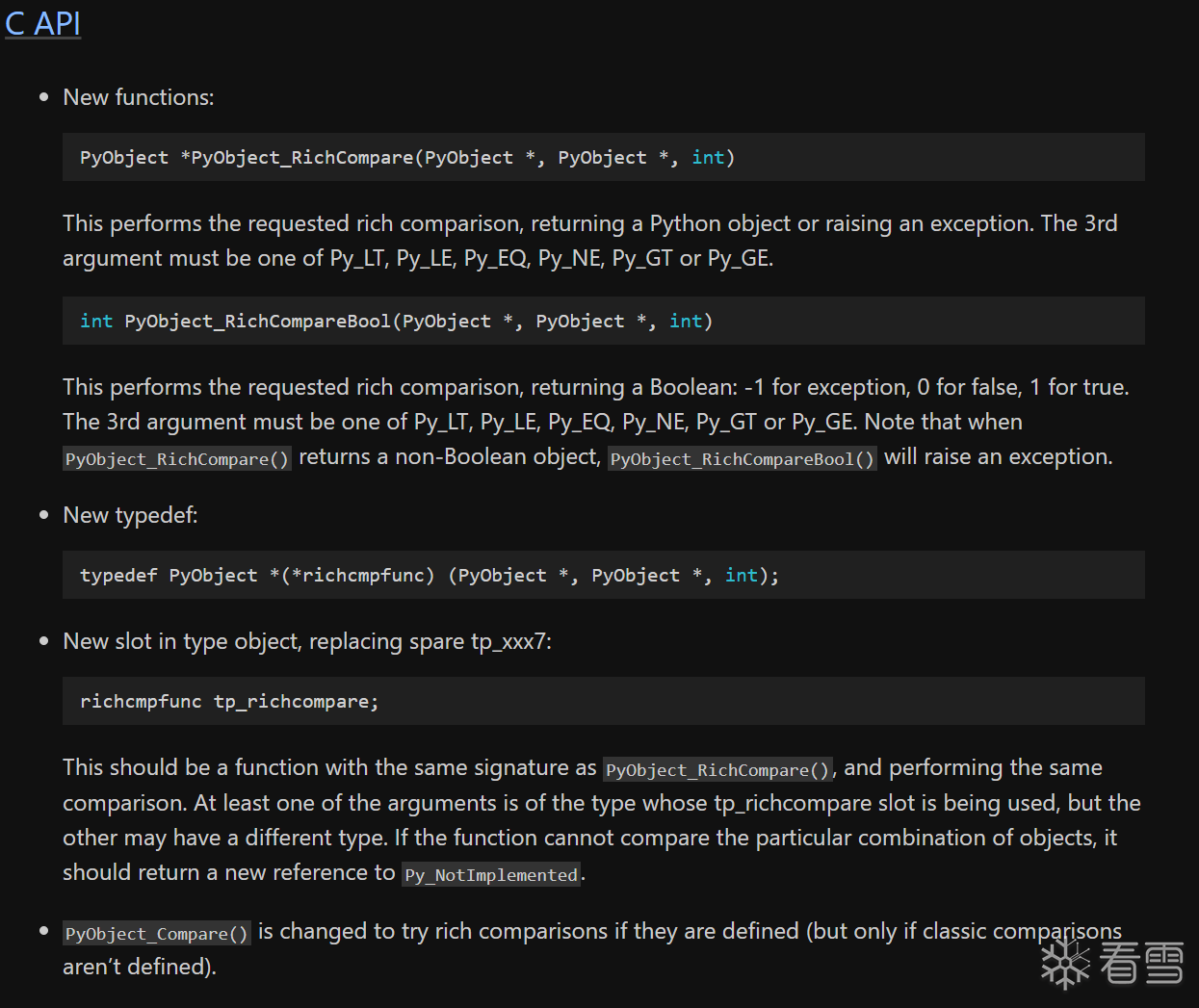
简单来说就是一个比较函数,返回一个布尔值(异常返回-1,结果为假0,为真返回1)
第三个参数的op为6种比较操作符之一
Py_LT(1):小于 < Py_LE(2):小于等于 <= Py_EQ(3):等于 == Py_NE(4):不等于 != Py_GT(5):大于 > Py_GE(6):大于等于 >=
9.test_string() 分析
1 2 3 4 5 6 7 8 9 10 11 | def test_string(): x = "I am str." y = len(x) z = x[1] w = x[2:] print(x, y, z, w) if "am" in x: print("yes") else: print("w |
对照源码分析
1 2 3 4 5 6 7 8 9 10 11 12 13 14 15 16 17 18 19 20 21 22 23 24 25 26 27 28 29 30 31 32 33 34 35 36 37 38 39 40 41 42 43 44 45 46 47 48 49 | def test_string():+041: x = "I am str." __Pyx_INCREF(__pyx_kp_s_I_am_str);//这里是前面说过的回收站机制,为字符串__pyx_kp_s_I_am_str添加引用计数 __pyx_v_x = __pyx_kp_s_I_am_str;//赋值+042: y = len(x) __pyx_t_1 = PyObject_Length(__pyx_v_x); //获取长度,并将长度保存在t_1中 if (unlikely(__pyx_t_1 == ((Py_ssize_t)-1))) __PYX_ERR(0, 42, __pyx_L1_error)//检查长度是否异常 __pyx_v_y = __pyx_t_1;//将长度赋值给y+043: z = x[1] __pyx_t_2 = __Pyx_GetItemInt(__pyx_v_x, 1, long, 1, __Pyx_PyInt_From_long, 0, 0, 1); //将x中索引次数为1的字符存储在t_2中 if (unlikely(!__pyx_t_2)) __PYX_ERR(0, 43, __pyx_L1_error)//检测是否存储成功,错误则跳转到__pyx_L1_error __Pyx_GOTREF(__pyx_t_2);//继续增加该字符串的计数,防止回收 __pyx_v_z = __pyx_t_2; __pyx_t_2 = 0;//重置临时变量t_2+044: w = x[2:] __pyx_t_2 = __Pyx_PyObject_GetSlice(__pyx_v_x, 2, 0, NULL, NULL, &__pyx_slice__4, 1, 0, 1); //获取字符串 x 的切片,从索引 2 开始,直到结束,并将结果存储在 __pyx_t_2 中 if (unlikely(!__pyx_t_2)) __PYX_ERR(0, 44, __pyx_L1_error) __Pyx_GOTREF(__pyx_t_2); __pyx_v_w = __pyx_t_2; __pyx_t_2 = 0;/* … */ __pyx_slice__4 = PySlice_New(__pyx_int_2, Py_None, Py_None); //创建一个新的 PySlice 对象,表示从索引 2 开始直到末尾 if (unlikely(!__pyx_slice__4)) __PYX_ERR(0, 44, __pyx_L1_error) __Pyx_GOTREF(__pyx_slice__4); __Pyx_GIVEREF(__pyx_slice__4);+045: print(x, y, z, w) __pyx_t_2 = PyInt_FromSsize_t(__pyx_v_y); //将 y 转换为 Python 整数对象,并将结果存储在 __pyx_t_2 中 if (unlikely(!__pyx_t_2)) __PYX_ERR(0, 45, __pyx_L1_error) __Pyx_GOTREF(__pyx_t_2); __pyx_t_3 = PyTuple_New(4); //创建一个新的 Python 元组,大小为 4 if (unlikely(!__pyx_t_3)) __PYX_ERR(0, 45, __pyx_L1_error) __Pyx_GOTREF(__pyx_t_3); __Pyx_INCREF(__pyx_v_x); __Pyx_GIVEREF(__pyx_v_x); if (__Pyx_PyTuple_SET_ITEM(__pyx_t_3, 0, __pyx_v_x)) __PYX_ERR(0, 45, __pyx_L1_error);//将 __pyx_t_x(即 y)设置为元组的第一个元素 __Pyx_GIVEREF(__pyx_t_2); if (__Pyx_PyTuple_SET_ITEM(__pyx_t_3, 1, __pyx_t_2)) __PYX_ERR(0, 45, __pyx_L1_error);//将 __pyx_t_2(即 y)设置为元组的第二个元素 __Pyx_INCREF(__pyx_v_z); __Pyx_GIVEREF(__pyx_v_z); if (__Pyx_PyTuple_SET_ITEM(__pyx_t_3, 2, __pyx_v_z)) __PYX_ERR(0, 45, __pyx_L1_error);//将 z 设置为元组的第三个元素 __Pyx_INCREF(__pyx_v_w); __Pyx_GIVEREF(__pyx_v_w); if (__Pyx_PyTuple_SET_ITEM(__pyx_t_3, 3, __pyx_v_w)) __PYX_ERR(0, 45, __pyx_L1_error);//将 w 设置为元组的第四个元素 __pyx_t_2 = 0; __pyx_t_2 = __Pyx_PyObject_Call(__pyx_builtin_print, __pyx_t_3, NULL); if (unlikely(!__pyx_t_2)) __PYX_ERR(0, 45, __pyx_L1_error) __Pyx_GOTREF(__pyx_t_2); __Pyx_DECREF(__pyx_t_3); __pyx_t_3 = 0; __Pyx_DECREF(__pyx_t_2); __pyx_t_2 = 0; |
切片访问
从一个序列(如列表、元组或字符串)中提取一个子序列
__pyx_t_2 = __Pyx_PyObject_GetSlice(__pyx_v_x, 2, 0, NULL, NULL, &__pyx_slice__4, 1, 0, 1);
cython实现
通过__Pyx_PyObject_GetSlice辅助函数
__pyx_v_x: 这是需要进行切片操作的 Python 对象
2: 这是切片操作的起始索引。即,从索引 2 开始进行切片
0: 这是切片操作的结束索引(0一般表示切片一直进行到对象的末尾)
&__pyx_slice__4代表一个包含切片信息的 PyObject,实际相当于 slice(2, None)
python中实现
1 | sequence[start:stop:step] |
start: 切片开始的索引(包括)
stop: 切片结束的索引(不包括)
step: 步长,表示从 start 到 stop 之间每隔多少个元素取一个
示例:
1 2 3 4 | s = "I am a string"print(s[2:7]) # 输出 "am a "print(s[::2]) # 输出 "Ia tig"print(s[::-1]) # 输出 "gnirts a ma I" |
索引访问
索引访问只能获取单个元素,而不能获取多个元素或子序列
1 2 3 | s = "I am a string"print(s[0]) # 输出 "I"print(s[-1]) # 输出 "g" |
10.test_for()分析
源码
1 2 3 4 5 | def test_for(): s = 0 for i in range(101): s = s + i print(s)对照源码分析 |
1 2 3 4 5 6 7 8 9 10 11 12 13 14 15 16 17 18 19 20 21 22 | def test_for():+080: s = 0+081: for i in range(101): for (__pyx_t_1 = 0;__pyx_t_1 < 0x65;__pyx_t_1+=1) {//初始化循环变量__pyx_t_1,设置循环变量的大小 __pyx_t_2 = __Pyx_PyInt_From_long(__pyx_t_1); //类型转换 if (unlikely(!__pyx_t_2)) __PYX_ERR(0, 81, __pyx_L1_error)//异常判断 __Pyx_GOTREF(__pyx_t_2);//计数 __Pyx_XDECREF_SET(__pyx_v_i, __pyx_t_2);//引用的回收释放 __pyx_t_2 = 0; +082: s = s + i __pyx_t_2 = PyNumber_Add(__pyx_v_s, __pyx_v_i); //调用windows的api进行加法 if (unlikely(!__pyx_t_2)) __PYX_ERR(0, 82, __pyx_L1_error) __Pyx_GOTREF(__pyx_t_2); __Pyx_DECREF_SET(__pyx_v_s, __pyx_t_2); __pyx_t_2 = 0; }+083: print(s) __pyx_t_2 = __Pyx_PyObject_CallOneArg(__pyx_builtin_print, __pyx_v_s); if (unlikely(!__pyx_t_2)) __PYX_ERR(0, 83, __pyx_L1_error) __Pyx_GOTREF(__pyx_t_2); __Pyx_DECREF(__pyx_t_2); __pyx_t_2 = 0; |
11.test_list()分析
1 2 3 4 5 6 7 8 9 10 11 12 13 | def test_list(): x = list() x.append(1) x.append(2) x.append(3) x.append(4) x.append("five") print(x) print(len(x)) for i in x: print(i) x = x[1:] x[2:4] = [22, 33] |
对照源码分析
1 2 3 4 5 6 7 8 9 10 11 12 13 14 15 16 17 18 19 20 21 22 23 24 25 26 27 28 29 30 31 32 33 34 35 36 37 38 39 40 41 42 43 44 45 46 47 48 49 50 51 52 53 54 55 56 57 58 59 60 61 | def test_list():+053: x = list()//创建一个空列表 __pyx_t_1 = PyList_New(0); if (unlikely(!__pyx_t_1)) __PYX_ERR(0, 53, __pyx_L1_error)//PyList_New(0)调用Python的C API函数来创建一个新列表 __Pyx_GOTREF(__pyx_t_1);//__Pyx_GOTREF宏用于管理引用计数,确保回收机制的正常运行 __pyx_v_x = ((PyObject*)__pyx_t_1); __pyx_t_1 = 0;+054: x.append(1)//向列表添加元素+055: x.append(2)+056: x.append(3)+057: x.append(4)+058: x.append("five")+059: print(x)//每一行x.append(...)调用都被转换为调用__Pyx_PyObject_Append函数,该函数执行实际的附加操作,并处理可能的错误 __pyx_t_1 = __Pyx_PyObject_CallOneArg(__pyx_builtin_print, __pyx_v_x); if (unlikely(!__pyx_t_1)) __PYX_ERR(0, 59, __pyx_L1_error)/ __Pyx_GOTREF(__pyx_t_1); __Pyx_DECREF(__pyx_t_1); __pyx_t_1 = 0;+060: print(len(x)) __pyx_t_3 = __Pyx_PyList_GET_SIZE(__pyx_v_x); if (unlikely(__pyx_t_3 == ((Py_ssize_t)-1))) __PYX_ERR(0, 60, __pyx_L1_error) __pyx_t_1 = PyInt_FromSsize_t(__pyx_t_3); if (unlikely(!__pyx_t_1)) __PYX_ERR(0, 60, __pyx_L1_error) __Pyx_GOTREF(__pyx_t_1); __pyx_t_4 = __Pyx_PyObject_CallOneArg(__pyx_builtin_print, __pyx_t_1); if (unlikely(!__pyx_t_4)) __PYX_ERR(0, 60, __pyx_L1_error) __Pyx_GOTREF(__pyx_t_4); __Pyx_DECREF(__pyx_t_1); __pyx_t_1 = 0; __Pyx_DECREF(__pyx_t_4); __pyx_t_4 = 0;///调用__Pyx_PyList_GET_SIZE用于获取列表的长度,然后再调用__Pyx_PyObject_CallOneArg调用Python的print函数打印列表x及其长度+061: for i in x: __pyx_t_4 = __pyx_v_x; __Pyx_INCREF(__pyx_t_4); __pyx_t_3 = 0; for (;;) { { Py_ssize_t __pyx_temp = __Pyx_PyList_GET_SIZE(__pyx_t_4); #if !CYTHON_ASSUME_SAFE_MACROS if (unlikely((__pyx_temp < 0))) __PYX_ERR(0, 61, __pyx_L1_error) #endif if (__pyx_t_3 >= __pyx_temp) break; } #if CYTHON_ASSUME_SAFE_MACROS && !CYTHON_AVOID_BORROWED_REFS __pyx_t_1 = PyList_GET_ITEM(__pyx_t_4, __pyx_t_3); __Pyx_INCREF(__pyx_t_1); __pyx_t_3++; if (unlikely((0 < 0))) __PYX_ERR(0, 61, __pyx_L1_error) #else __pyx_t_1 = __Pyx_PySequence_ITEM(__pyx_t_4, __pyx_t_3); __pyx_t_3++; if (unlikely(!__pyx_t_1)) __PYX_ERR(0, 61, __pyx_L1_error) __Pyx_GOTREF(__pyx_t_1); #endif __Pyx_XDECREF_SET(__pyx_v_i, __pyx_t_1); __pyx_t_1 = 0;/* … */ } __Pyx_DECREF(__pyx_t_4); __pyx_t_4 = 0;+062: print(i) __pyx_t_1 = __Pyx_PyObject_CallOneArg(__pyx_builtin_print, __pyx_v_i); if (unlikely(!__pyx_t_1)) __PYX_ERR(0, 62, __pyx_L1_error) __Pyx_GOTREF(__pyx_t_1); __Pyx_DECREF(__pyx_t_1); __pyx_t_1 = 0;//通过PyList_GET_ITEM来获取每个元素,并实现for循环通过__Pyx_PyObject_CallOneArg调用print函数来打印获取到的元素+063: x = x[1:]+064: x[2:4] = [22, 33] __pyx_t_4 = PyList_New(2); if (unlikely(!__pyx_t_4)) __PYX_ERR(0, 64, __pyx_L1_error) __Pyx_GOTREF(__pyx_t_4); __Pyx_INCREF(__pyx_int_22); __Pyx_GIVEREF(__pyx_int_22); if (__Pyx_PyList_SET_ITEM(__pyx_t_4, 0, __pyx_int_22)) __PYX_ERR(0, 64, __pyx_L1_error); __Pyx_INCREF(__pyx_int_33); __Pyx_GIVEREF(__pyx_int_33); if (__Pyx_PyList_SET_ITEM(__pyx_t_4, 1, __pyx_int_33)) __PYX_ERR(0, 64, __pyx_L1_error); if (__Pyx_PyObject_SetSlice(__pyx_v_x, __pyx_t_4, 2, 4, NULL, NULL, NULL, 1, 1, 1) < 0) __PYX_ERR(0, 64, __pyx_L1_error)//通过__Pyx_PyObject_SetSlice对列表进行切片 __Pyx_DECREF(__pyx_t_4); __pyx_t_4 = 0;//列表[22, 33]赋值给x[2:4] |
12.test_dict() 分析
1 2 3 4 5 6 7 8 9 10 11 12 | def test_dict(): x = {} x["one"] = 1 x["two"] = 2 x["three"] = 3 y = x["one"] z = x["two"] if "one" in x: print(y) for k in x: print(k, x[k]) |
对照源码分析
1 2 3 4 5 6 7 8 9 10 11 12 13 14 15 16 17 18 19 20 21 22 23 24 25 26 27 28 29 30 31 | def test_dict():+067: x = {} __pyx_v_x = PyDict_New(); if (unlikely(!__pyx_v_x)) __PYX_ERR(0, 67, __pyx_L1_error) __Pyx_GOTREF(__pyx_v_x);//初始化空字典x+068: x["one"] = 1 if (unlikely((PyDict_SetItem(__pyx_v_x, __pyx_n_s_one, __pyx_int_1) < 0))) __PYX_ERR(0, 68, __pyx_L1_error)//x["key"] = value调用被转换为调用PyDict_SetItem函数,并且处理可能的错误+069: x["two"] = 2 if (unlikely((PyDict_SetItem(__pyx_v_x, __pyx_n_s_two, __pyx_int_2) < 0))) __PYX_ERR(0, 69, __pyx_L1_error)+070: x["three"] = 3 if (unlikely((PyDict_SetItem(__pyx_v_x, __pyx_n_s_three, __pyx_int_3) < 0))) __PYX_ERR(0, 70, __pyx_L1_error)//向字典加入键值对 +071: y = x["one"] __pyx_t_1 = __Pyx_PyDict_GetItem(__pyx_v_x, __pyx_n_s_one); if (unlikely(!__pyx_t_1)) __PYX_ERR(0, 71, __pyx_L1_error)//__Pyx_PyDict_GetItem用于从字典中获取指定键的值 __Pyx_GOTREF(__pyx_t_1); __pyx_v_y = __pyx_t_1; __pyx_t_1 = 0;//从字典x中获取键为"one"和"two"的值,并将其分别赋给变量y和z+072: z = x["two"] __pyx_t_1 = __Pyx_PyDict_GetItem(__pyx_v_x, __pyx_n_s_two); if (unlikely(!__pyx_t_1)) __PYX_ERR(0, 72, __pyx_L1_error)//__Pyx_PyDict_ContainsTF用于检查字典中是否包含指定键,并返回布尔值 __Pyx_GOTREF(__pyx_t_1); __pyx_v_z = __pyx_t_1; __pyx_t_1 = 0;+073: if "one" in x: __pyx_t_2 = (__Pyx_PyDict_ContainsTF(__pyx_n_s_one, __pyx_v_x, Py_EQ)); if (unlikely((__pyx_t_2 < 0))) __PYX_ERR(0, 73, __pyx_L1_error) if (__pyx_t_2) {/* … */ }+074: print(y) |
13.test_datetime () 分析
1 2 3 4 5 6 7 8 9 10 11 12 13 14 15 16 17 18 19 20 21 22 23 24 25 26 27 28 29 30 31 32 33 34 35 36 37 38 | +103: def test_datetime():+104: x = datetime.datetime.now() __Pyx_GetModuleGlobalName(__pyx_t_2, __pyx_n_s_datetime); if (unlikely(!__pyx_t_2)) __PYX_ERR(0, 104, __pyx_L1_error) __Pyx_GOTREF(__pyx_t_2);//从全局命名空间中获取datetime模块对象,并存储在__pyx_t_2中 __pyx_t_3 = __Pyx_PyObject_GetAttrStr(__pyx_t_2, __pyx_n_s_datetime); ////释放__pyx_t_3的引用计数if (unlikely(!__pyx_t_3)) __PYX_ERR(0, 104, __pyx_L1_error) __Pyx_GOTREF(__pyx_t_3);//释放__pyx_t_3的引用计数 __Pyx_DECREF(__pyx_t_2); __pyx_t_2 = 0; __pyx_t_2 = __Pyx_PyObject_GetAttrStr(__pyx_t_3, __pyx_n_s_now); if (unlikely(!__pyx_t_2)) __PYX_ERR(0, 104, __pyx_L1_error) __Pyx_GOTREF(__pyx_t_2); __Pyx_DECREF(__pyx_t_3); __pyx_t_3 = 0;//释放__pyx_t_3的引用计数 __pyx_t_3 = NULL; __pyx_t_4 = 0; #if CYTHON_UNPACK_METHODS if (likely(PyMethod_Check(__pyx_t_2))) { __pyx_t_3 = PyMethod_GET_SELF(__pyx_t_2);//先检查__pyx_t_2是否是一个方法,并获取它的self if (likely(__pyx_t_3)) { PyObject* function = PyMethod_GET_FUNCTION(__pyx_t_2); __Pyx_INCREF(__pyx_t_3); __Pyx_INCREF(function); __Pyx_DECREF_SET(__pyx_t_2, function); __pyx_t_4 = 1; } } #endif { PyObject *__pyx_callargs[2] = {__pyx_t_3, NULL}; __pyx_t_1 = __Pyx_PyObject_FastCall(__pyx_t_2, __pyx_callargs+1-__pyx_t_4, 0+__pyx_t_4);//使用__Pyx_PyObject_FastCall快速调用该方法,将结果存储在__pyx_v_x中 __Pyx_XDECREF(__pyx_t_3); __pyx_t_3 = 0; if (unlikely(!__pyx_t_1)) __PYX_ERR(0, 104, __pyx_L1_error) __Pyx_GOTREF(__pyx_t_1); __Pyx_DECREF(__pyx_t_2); __pyx_t_2 = 0; } __pyx_v_x = __pyx_t_1; __pyx_t_1 = 0;+105: print(x)//调用print函数打印当前时间 |
14.test_format() 分析
1 2 3 4 5 | def test_format(): x = 1 y = "One" z = "%s is %d" % (y, x) print(z) |
对照源码分析
1 2 3 4 5 6 7 8 9 10 11 12 13 14 15 16 17 18 19 20 21 | def test_format():+108: x = 1+109: y = "One"+110: z = "%s is %d" % (y, x) __pyx_t_1 = __Pyx_PyInt_From_long(__pyx_v_x); if (unlikely(!__pyx_t_1)) __PYX_ERR(0, 110, __pyx_L1_error)//__Pyx_PyInt_From_long是一个宏,将C语言中的long类型转换为Python的int类型 __Pyx_GOTREF(__pyx_t_1); __pyx_t_2 = PyTuple_New(2); if (unlikely(!__pyx_t_2)) __PYX_ERR(0, 110, __pyx_L1_error)//创建一个新的Python元组对象,长度为2,并将其引用存储在__pyx_t_2中 __Pyx_GOTREF(__pyx_t_2); __Pyx_INCREF(__pyx_v_y); __Pyx_GIVEREF(__pyx_v_y); if (__Pyx_PyTuple_SET_ITEM(__pyx_t_2, 0, __pyx_v_y)) __PYX_ERR(0, 110, __pyx_L1_error);//将y增加引用计数并赋值给元组的第一个元素 __Pyx_GIVEREF(__pyx_t_1); if (__Pyx_PyTuple_SET_ITEM(__pyx_t_2, 1, __pyx_t_1)) __PYX_ERR(0, 110, __pyx_L1_error);//__Pyx_PyString_Format是一个宏,用于执行Python的字符串格式化操作,__pyx_t_1赋值给元组的第二个元素,并将__pyx_t_1重置为0以释放其引用 __pyx_t_1 = 0; __pyx_t_1 = __Pyx_PyString_Format(__pyx_kp_s_s_is_d, __pyx_t_2); if (unlikely(!__pyx_t_1)) __PYX_ERR(0, 110, __pyx_L1_error)//使用__Pyx_PyString_Format进行字符串格式化操作,将结果存储在__pyx_t_1中 __Pyx_GOTREF(__pyx_t_1); __Pyx_DECREF(__pyx_t_2); __pyx_t_2 = 0; __pyx_v_z = ((PyObject*)__pyx_t_1); __pyx_t_1 = 0;+111: print(z) |
格式化字符串的汇编实现
mov r14, cs:___pyx_n_s_One
mov edi, 1 ; __int64
//edi 寄存器被加载为整数值 1,表示将整数 1 转换为 Python 的长整型对象,返回值存储在 rax 寄存器中,并且被复制到 r15 寄存器中
call _PyLong_FromLong
mov r15, rax ; r15 = _PyLong_FromLong(1)
mov edi, 2 ; size
//edi 寄存器被加载为 2,表示创建一个包含两个元素的元组
call _PyTuple_New
//_PyTuple_New 是 Python/C API 中的函数,用于创建一个新的元组对象。调用此函数后,返回值存储在 rax 寄存器中,并且被复制到 rbx 寄存器中
mov rbx, rax
mov [rax+18h], r14 ; "One"
//[rax+18h] 和 [rax+20h] 分别将字符串 "One" 和整数 1 存储到新创建的元组对象中的对应位置
mov [rax+20h], r15 ; 1
mov rdi, cs:___pyx_kp_s_s_is_d ; %s is %d
//rdi 寄存器被加载为 ___pyx_kp_s_s_is_d,这是一个常量字符串,在此处表示 "%s is %d" 的格式化模板
mov rsi, rax ; Tuple("One", 1)
call _PyUnicode_Format
//_PyUnicode_Format Python/C API 中的函数,用于根据格式化模板将元组中的值格式化成一个 Unicode 字符串,返回格式化后的 Unicode 字符串对象
4.利用frida获取UTF-8 dump 信息
动态调用 Python/C API 中的函数来实现在运行时获取 PyObject 指针对应的字符串表示形式的 UTF-8 dump 信息
==根据python将对象转换为UTF-8字符串的汇编实现,编译frida的脚本==
汇编实现
.text:00007FFBC501B615 mov rcx, rbx ; 将 rbx 寄存器中的值(Python 对象的地址)移动到 rcx 寄存器 .text:00007FFBC501B618 call python38_PyObject_Str ; 调用 PyObject_Str 函数,获取 Python 对象的字符串表示形式 .text:00007FFBC501B61D mov rcx, rax ; 将 rax 寄存器中的值(PyObject_Str 的返回值)移动到 rcx 寄存器 .text:00007FFBC501B620 call python38_PyUnicode_AsUTF8 ; 调用 PyUnicode_AsUTF8 函数,将字符串表示形式转换为 UTF-8 编码
frida脚本
1 2 3 4 5 6 7 8 9 10 11 12 13 14 15 16 17 18 19 20 21 22 23 24 25 26 27 | function DumpPyObject(address) { // 检查进程架构是否为 x64(64 位) if (Process.arch === "x64") { // 将地址转换为 NativePointer,以便可以在该地址处读取和写入内存 var native_address = new NativePointer(address); // 查找进程中加载的 "python38.dll" 模块。这包含我们所需的必要函数 var module = Process.findModuleByName("python38.dll"); // 获取 "python38.dll" 中导出函数 'PyObject_Str' 的地址。 // 'PyObject_Str' 用于获取 Python 对象的字符串表示形式 var PyObject_Str = new NativeFunction(module.findExportByName("PyObject_Str"), "pointer", ["pointer"], "win64"); // 获取 "python38.dll" 中导出函数 'PyUnicode_AsUTF8' 的地址。 // 'PyUnicode_AsUTF8' 将 Unicode 对象转换为 UTF-8 编码的字符串 var PyUnicode_AsUTF8 = new NativeFunction(module.findExportByName("PyUnicode_AsUTF8"), "pointer", ["pointer"], "win64"); // 使用 'PyObject_Str' 获取对象的字符串表示 var obj = PyObject_Str(native_address); // 将获取的 Unicode 对象转换为 UTF-8 字符串 var p = PyUnicode_AsUTF8(obj); // 读取并打印 UTF-8 编码的字符串 console.log(p.readUtf8String()); }} |
对应解析
1.将地址传递给 PyObject_Str 函数
汇编:
mov rcx, rbx
call python38_PyObject_Str
脚本:
1 | var obj = PyObject_Str(native_address); |
2.将 PyObject_Str 的返回值传递给 PyUnicode_AsUTF8 函数
汇编:
mov rcx, rax
call python38_PyUnicode_AsUTF8
脚本:
1 | var p = PyUnicode_AsUTF8(obj); |
3.读取并打印 UTF-8 字符串
脚本实现
1 | console.log(p.readUtf8String()); |
更多【茶余饭后-cython逆向-语言特性分析】相关视频教程:www.yxfzedu.com
相关文章推荐
- 智能手机-香港金融科技周VERTU CSO Sophie谈Web3.0的下一个风口 手机虚拟货币移动支付 - 其他
- 搜索引擎-外贸网站优化常用流程和一些常识 - 其他
- 电脑-PHP分类信息网站源码系统 电脑+手机+微信端三合一 带完整前后端部署教程 - 其他
- 智能手机-手机是否能登陆国际腾讯云服务器? - 其他
- 智能手机-GD32单片机远程升级下载,手机在线升级下载程序,GD32在线固件下载升级,手机下载程序固件方法 - 其他
- 华为-漏刻有时百度地图API实战开发(1)华为手机无法使用addEventListener click 的兼容解决方案 - 其他
- 架构-LoRaWAN物联网架构 - 其他
- clickhouse-【总结卡】clickhouse数据库常用高级函数 - 其他
- java-深入理解ClickHouse跳数索引 - 其他
- 小程序-小程序发成绩 - 其他
- 运维-墨者学院 Ruby On Rails漏洞复现第一题(CVE-2018-3760) - 其他
- fpga开发-「Verilog学习笔记」多功能数据处理器 - 其他
- 前端-TypeScript深度剖析:TypeScript 中枚举类型应用场景? - 其他
- java-Failure to find org.apache.maven.plugins:maven-resources- plugin:jar:3.8.1 - 其他
- 机器学习-Azure - 机器学习:使用自动化机器学习训练计算机视觉模型的数据架构 - 其他
- 网络-网络运维Day01 - 其他
- 机器学习-Azure 机器学习 - 设置 AutoML 训练时序预测模型 - 其他
- java-10-27 maven概念 - 其他
- java-Maven的总结 - 其他
- 学习-【Azure 架构师学习笔记】-Azure Storage Account(5)- Data Lake layers - 其他
2):严禁色情、血腥、暴力
3):严禁发布任何形式的广告贴
4):严禁发表关于中国的政治类话题
5):严格遵守中国互联网法律法规
6):有侵权,疑问可发邮件至service@yxfzedu.com
- 计算机视觉-Libra R-CNN: Towards Balanced Learning for Object Detection(2019.4)
- ar-Angular 由一个bug说起之一:List / Grid的性能问题
- vr-VR全景技术,为养老院宣传推广带来全新变革
- 网络-【广州华锐互动】VR安防网络综合布线仿真实训打造沉浸式的教学体验
- list-使用多线程处理List数据
- vr-【广州华锐互动】楼宇智能化VR虚拟教学系统
- 笔记-FreeRTOS源码阅读笔记2--list.c
- react.js-Antd React Form.Item内部是自定义组件怎么自定义返回值
- 区块链-2023年A股借壳上市研究报告
- spring-Spring Boot中处理简单的事务
接各种驱动定制如:游戏读写驱动,软件内存保护,防止调试等功能定制。
出租读写驱动,调试驱动,无痕注入支持各种游戏。
邮箱:service@yxfzedu.com
QQ:851920120
特别说明:不接游戏数据分析,外挂编写,登陆协议等类似业务。
